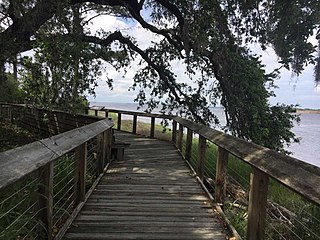 W
WBrunswick Town was a prominent town in colonial North Carolina. It was the first successful European settlement in the Cape Fear region, a major British port in the 18th century, and home to two provincial governors. Brunswick Town lasted 50 years (1726–1776) until it was raided by the British Army during the American Revolutionary War and never rebuilt. During the American Civil War, 86 years after the town was abandoned, a large portion of the town was covered by earthworks for the construction of Fort Anderson.
 W
WFort San Juan was a late 16th-century fort built by the Spanish under the command of conquistador Juan Pardo in the native village of Joara, in what is now Burke County, North Carolina. Used as an outpost for Pardo's expedition into the interior of what was known to the Spaniards as "la Florida", Fort San Juan was the foremost of six forts built and garrisoned by Pardo in modern-day North Carolina, South Carolina, and Tennessee to extend Spain's effective control deeper into the North American continent.
 W
WGarden Creek site is an archaeological site located 24 miles (39 km) west of Asheville, North Carolina in Haywood County at the confluence of the Pigeon River and Garden Creek near Canton and the Pisgah National Forest. The site features two Pisgah Phase villages (31Hw7) and the three Garden Creek Mounds (31Hw1-3). The two villages located on the site were occupied from 600 CE to 1200 CE, first by Woodland period Hopewellian peoples and later by Pisgah Phase people of the South Appalachian Mississippian culture.
 W
WThe Hardaway Site, designated by the Smithsonian trinomial 31ST4, is an archaeological site near Badin, North Carolina. A National Historic Landmark, this multi-layered site has seen major periods of occupation as far back as 10,000 years. Materials from this site were and are used to assist in dating materials from other sites in the eastern United States. The site was declared a National Historic Landmark in 1990.
 W
WJoara was a large Native American settlement, a regional chiefdom of the Mississippian culture, located in what is now Burke County, North Carolina, about 300 miles from the Atlantic coast in the foothills of the Blue Ridge Mountains. Joara is notable as a significant archaeological and historic site, where Mississippian and European artifacts have been found, in addition to an earthwork mound and remains of a 16th-century Spanish fort.
 W
WNikwasi comes from the Cherokee word for "star", Noquisi (No-kwee-shee). It is the name and site of a Cherokee town in far western North Carolina, which is first documented in colonial records in the early 18th century. The site includes a platform mound, which was listed on the National Register of Historic Places in 1980. Since the mid-20th century, this site has been owned and managed by the present-day town of Franklin.
 W
WThe Ravensford Site is an old archaeological site located in the state of North Carolina, specifically within modern-day Swain County of the Appalachian Summit Region. Slightly north of the town of Cherokee, it sits at the edge of Oconaluftee River along the Raven Fork tributary on the Qualla Boundary. Its current elevation is 2,012 feet.
 W
WStagville Plantation is located in Durham County, North Carolina. With buildings constructed from the late 18th century to the mid-19th century, Stagville was part of one of the largest plantation complexes in the American South. The entire complex was owned by the Bennehan, Mantack and Cameron families; it comprised roughly 30,000 acres (120 km2) and was home to almost 900 enslaved African-Americans in 1860.
 W
WToo-Cowee, was an important Cherokee town located near the Little Tennessee River north of present-day Franklin, North Carolina, one of what were called the Middle Towns. The name translates to "pig fat" in English.